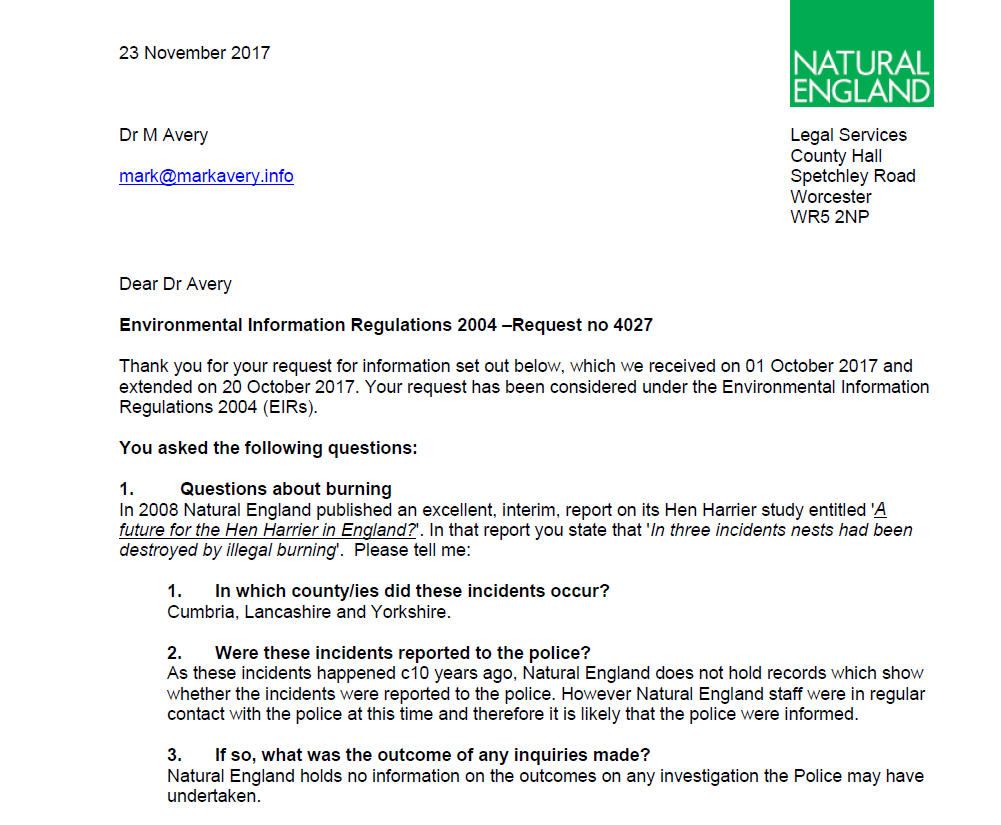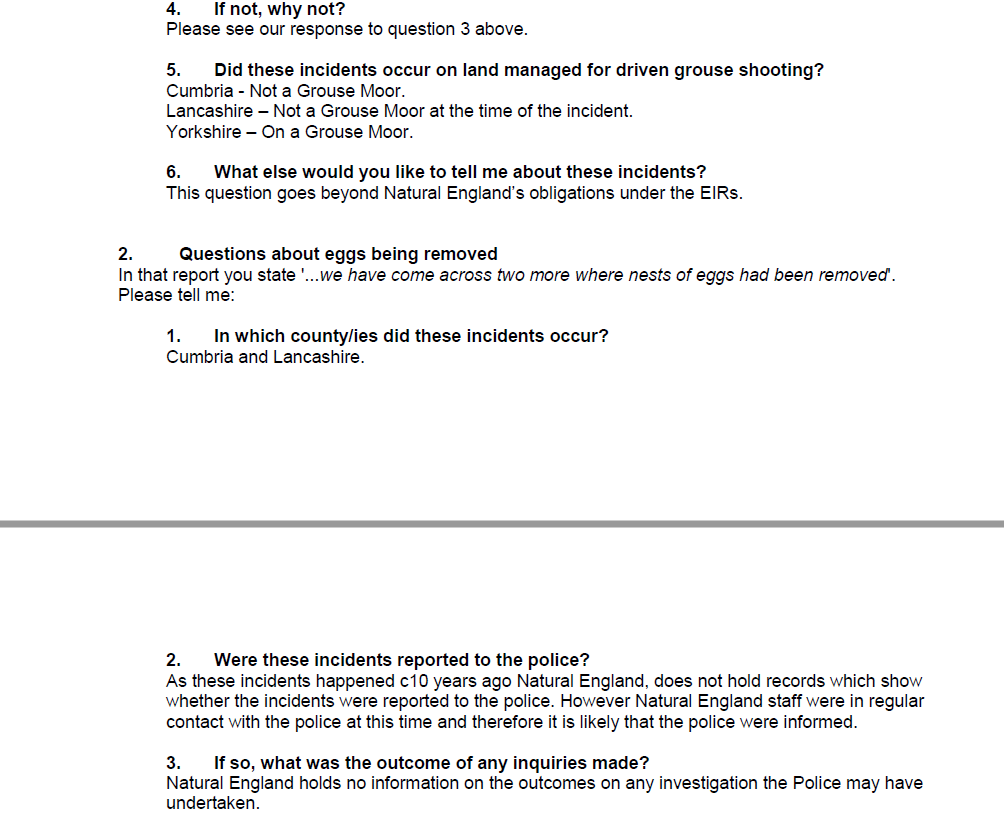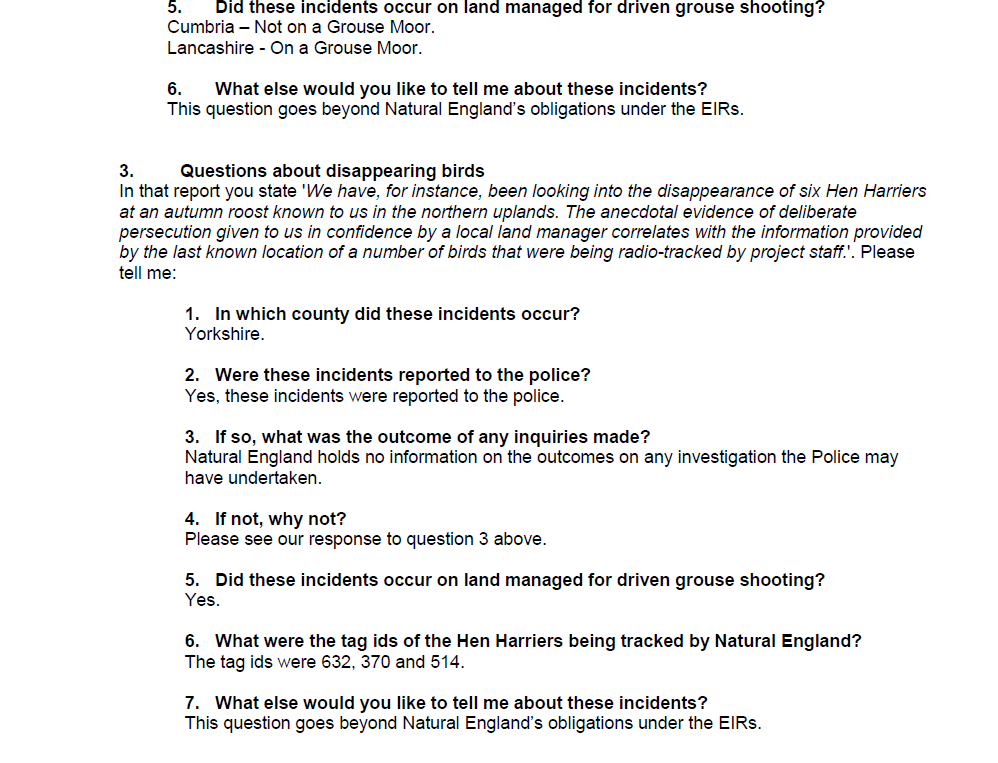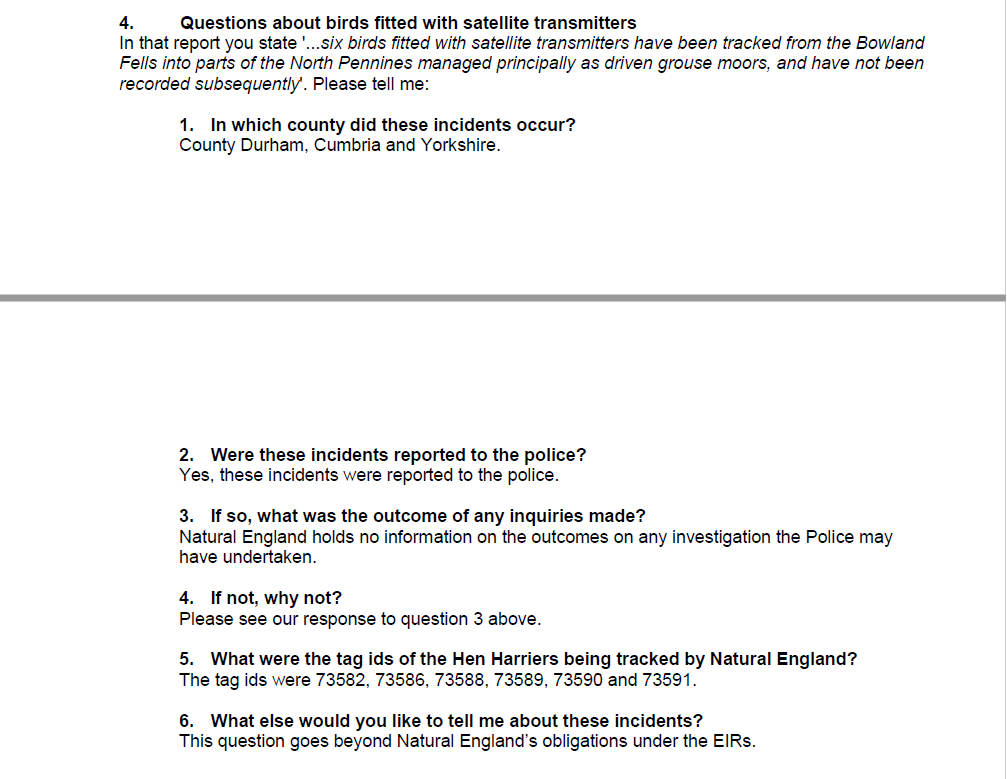Back on 1 October I asked NE some questions. They asked for extra time to answer them and I had a response yesterday afternoon.
The questions related to an excellent NE publication of 2008 entitled ‘A future for hen harriers in England?’ which it is well worth having a good look at, and asking yourself whether you have seen any similar publication from NE on their continuing study in the last 9 years (hint – you haven’t!).
Here is the response.




Questions 1 and 2: Natural England admit that they can’t be sure whether or not they reported three illegal acts of heather burning and two cases of nests with eggs being ‘removed’ (sounds illegal to me!) to the Police. That’s inept of them to say the least.
Question 3: this was the case of six Hen Harriers disappearing at an autumn roost. We now learn that this was on a Yorkshire grouse moor, as I rather suspected it was – in fact I reckon I know exactly where it was (I’d put my money on it being west of the A1 for a start!). We also learn that three of the birds were radio-tagged by NE. NE supply three tag ids for these birds and we can check them against the skeletal information released, under pressure, by NE in September this year.
Tags 632, 514 and 370 were all fitted in Bowland in June 2003 and ceased transmitting on 5 September 2003, 16 September 2003 and 8 October 2003 respectively. These tags are all listed in the September 2017 data ‘release’ as ‘Missing Fate Unknown’ but we now know that NE were told that they had been bumped off, along with three other birds apparently, at an autumn roost over a period of just over a month.
Question 4: this was a question about six satellite-tagged Hen Harriers from Bowland into parts of the North Pennines which were managed primarily for grouse shooting. In the 2008 report these were all mentioned in a section on suspected persecution incidents.
The tag id 73586 is, according to the data ‘release’ of September this year, a tag that was fitted in Cumbria, not Bowland. Whilst it is possible that the tag was fitted in Cumbria and then the bird passed through Bowland on its way to its demise in Yorkshire this would be a strange way to describe the bird. I’ll ask NE why there is this apparent contradiction between the only two versions of the data that are in the public domain.
There’s something odd about tag id 73591 too. This bird was tagged in Bowland in June 2008 and ceased transmission in Bowland in September 2008. Bowland is not in the North Pennines and so it is difficult to see how this bird got into this list. I’ll ask NE to clarify.
And there’s something very odd about tag id 73588 which certainly didn’t travel far as it was tagged in Bowland on 7 July 2008 and ceased transmitting in Bowland on that very day according to the data ‘release’ of September this year. I’ll ask NE to clarify.
That leaves three other birds, all tagged in Bowland (at least we are told they were) in 2008 and ceasing transmission on grouse moors in Co Durham (tag 73582 – October 2007), Cumbria (tag 73589 – September 2007) and Sheffield (presumably the Peak District, tag 73590 – October 2007).
So what should we take from the NE response?
- Natural England doesn’t want to answer questions of this type about our data (we paid for its collection) and have done the least possible to answer these questions. Whether that is because they got out of bed on the wrong side, whether it is because they are extremely sensitive about how little this study has produced over such a long period of time, whether it is because there is lots of interesting information that NE don’t want anyone to know, or whether it’s because the dataset is in a complete mess is difficult to know. Other explanations are also possible.
- There are numerous apparent contradictions between the data released to me and the data published in September 2017. I#m concerned that this will reduce the credibility of NE’s data curation and will open it up to attack whatever the data are said to show, if they are ever properly analysed and published.
- Natural England, the statutory nature conservation organisation for England, doesn’t know whether it reported wildlife crimes to the Police. This is shocking and inept. I’ll be asking NE for more details of these alleged offences so that I can take them up with the relevant police forces.
- All the Hen Harriers which had been tagged by NE and described by them in their 2008 report as known or suspected persecution incidents are listed in their September 2017 data ‘release’ as ‘Missing Fate Unknown’. This might well mean that NE has strong suspicions or evidence on the fate of other satellite-tagged Hen Harriers that are in the ‘Missing Fate unknown’ category.
I’d love to know where the grouse moor in Yorkshire is where NE believe that six Hen Harriers disappeared at an autumn roost in 2003. I’d love to know what has been NE’s relationship with that grouse moor since that time and how much public money has been paid to that estate. I’d love to know whether the owners of that grouse moor are members of the Moorland Association, whether they are involved with any National Parks or AONBs in the area, whether their keepers are members of the National Gamekeepers’ Organisation and a whole bunch of other information.
But I do know that Natural England is not fit for purpose.
[registration_form]
They probably want to discredit their own data, because of what it shows. They release a load of contradictory low resolution data. They cant release high resolution data because of it’s apparent sensitivity. Thus they wriggle from the hook.
Great work Mark, please keep it up. I’ll keep donating to BAWC to hopefully get more tagging data that will actually be used properly against crime.
Superb work, Mark, thank you.
I hate to criticise what is otherwise an excellent bit of investigative work by Mark, but I think he’s being a tad unfair about NE record keeping, and that detracts from the power of his other criticisms.
In the past decade the physical location of any paper records held by them will have moved multiple times, the computerised record systems will have been archived and are probably now in a format that can’t easily be read, and pretty much all the staff involved will be long gone. I suspect that any organisation I have ever worked for would struggle to find definitive records from 10 years ago, and I still get the occasional request for help from an organisation I left nearly 20 years ago because I’m the last bit of corporate memory available.
If NE should have kept better records, my sense is that the same could be said of pretty much everyone else, so I think that to single them out is, as I say, unfair.
jbc – they don’t know whether they reported crimes to the police!
There has certainly been a staff member who was involved throughout this period on this project.
I am completely confident that the RSPB Investigations team could produce this information from 10 years ago.
But as we established in Ipswich, the RSPB has perhaps gone downhill since you left!
Seriously, though, if there’s been has been a continuity of staff involved then I retract my criticism.
Sorry Jbc that just does’t hold up.
We aren’t talking about some missing receipts or parking tickets.
This is serious research data.
Great detective work Mark.
On-going research, publicly funded and with high public interest.
!0 years is not a long time for computerised records. I believe the title was ‘A *future* for Hen Harriers in England’. Did that mean a future which was not then expected to last 10 years? Unless Natural England were in the habit of creating their own database software (do they employ specialised staff just to do that?), they most likely used commercial software. In which case, the created databases will have been supported by new releases… or converted for use by new releases.
It is possible, of course, that Natural England’s funding had been cut and forced the databases to be scrapped. Which of itself is a pretty serious action from a statutory body.
Of course I don’t know whether the fire was reported to the police but I do know about that fire. Right at the end of the burning season, a fire lit by a tenant farmer on a day when it should never have happened because it was too windy by far. Inevitably it became uncontrolled and burnt through three harrier nests.
The roost is infamous in these parts and it is common knowledge amongst harrier workers and raptor workers in this area, interestingly they are not or were not at the time members of the MA. Mark you have been interviewed with it in the back ground but I don’t think you have been on that moor.
I have been on that moor and if you think “Mr Angry” near Blubberhouses was bad the keeper here and his brother make him look positively mild and polite. I had to that point not quite realised how often the F word could be used in a single sentence and it still be almost coherent! And these people are allowed firearms!!!!
IT would be good for Mr Gove to see this correspondence.
It would be much better for Michael Gove to actually take an interest in this subject and to use his powers to do something about it.
Interesting to see how NE’s reluctance to release information (and that of other statutory agencies) in this and other cases marries with the guidelines for the display of sensitive species information shared with the NBN Atlas. The sensitive species lists (see https://nbn.org.uk/sensitive-data/ and https://nbnatlas.org/help/sensitive-species/sensitive-species-list/) which have been ‘agreed by the UK’s statutory bodies and relevant experts’ show that display of records (without detailed attributes) is possible on the NBN atlas at 10km sq scale. And that I believe is the public resolution of all Hen Harrier records on the NBN Atlas. In the spirit of Natural England’s open data mantra (which they highlighted as a key reason for withdrawing funding from Local Environmental Records Centres – https://www.theguardian.com/environment/2016/mar/06/decision-to-end-funding-of-local-environmental-record-centres-attacked-natural-england-data-collection-contract) isn’t it about time that the records from the 2008 study were shared with the NBN atlas and made available at 10km sq resolution…
Perhaps Mr Carter can shed some light on this – give us chapter and verse, like…
How much has the unpublished EN/NE Hen Harrier study cost the tax payer? Stick that in your next FOI please Mark and RPUK
A small point, but Yorkshire comprises three counties, not one, so the information could be more precise.
Mark, well done for keeping up this pressure. Those who are aware of my commenting on this matter will be aware that I have repeatedly referenced the 2008 NE report “A future for Hen Harriers in England”. At the time this report was published it was quite radical as it put the emphasis on the failure of breeding Hen Harriers in England squarely on shooting interests.
This issue also highlights the complexity of the problem and why my apparent disagreement with Mark on this issue is in fact a serious misunderstanding. The reason I say Mark’s assertion that “Natural England is not fit for purpose” is not helpful is because it falsely insinuates that the problem is the institutional failing of NE. Whereas actually most NE staff are probably on the side of Mark on this issue. What I am saying is that this is a systematic problem which stretches well beyond NE. Also NE cannot address this problem without the whole-hearted support of the government.
This response to Mark highlights a key problem, which illustrates what I mean. It says that NE referred some of these matters to the police and have no idea what steps the police took to investigate this and what was the outcome. In other words it’s not just NE, but the police who are failing to take adequate action. Nor is it just the police. My point is that if the political control of these various agencies fail to back them up to take strong action against those responsible for the illegal persecution of birds of prey, then we will not see strong action.
Let me be very blunt about this. There have been many incidents indicating the illegal persecution of birds of prey on specific shooting estates or close by them. You don’t have to be Sherlock Holmes to narrow down the list of suspects and motives. In these instances there are a relatively small group of suspects in the frame. In fact many of these incidents repeatedly lead to the same small group of suspects. Therefore the million dollar question is why isn’t this very small pool of suspects put under much closer scrutiny by the authorities? This is after all what normally happens with instances of persistent crime, which is likely organized crime. Normally investigations become focused on the key suspects. The authorities don’t usually just shrug their shoulders and says it’s difficult to prove.
My general point is that the official bodies which are supposed to deal with this are in a difficult position because of the lack of political support in pursuing the culprits and bringing them to book. I should hardly need to explain why a Conservative government has no particular interest in exposing the culprits of this persistent and organized wildlife crime. If what was happening was broke open and exposed to the public it would be a national scandal. One of the most scandalous things would be why the authorities took no action before when it was pretty clear all along who the culprits were.
SteB1 – in your 127 comments here you have (as best I can see) mentioned the Natural England report twice – on 14 August 2016 and 15 August 2016. thank you for all your comments which are usually long but quite often interesting. At least, that’s how I think of them.
Mark, I didn’t mean on your blog. I meant on the Guardian, the old BBC Messageboards and elsewhere. I can happily dig them out and email them to you.
SteB1 – that’s OK thanks.